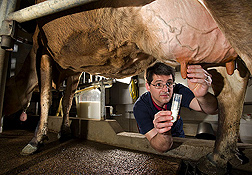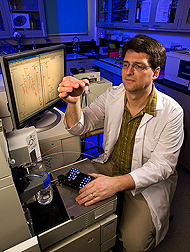Shotgun Proteomics
Detecting the Dairy Cow Immune Response Is a High-Tech Blast
The term “shotgun proteomics” may sound like research conducted by scientists operating outside the law. But molecular biologist John Lippolis is using it to close in on the dynamics of the dairy cow immune system.
“I want to be able to find something that dairy farmers will incorporate into their management practices,” Lippolis says. “They tend to be very cautious about adopting new practices unless there’s a clear benefit.”
Lippolis works at the Periparturient Diseases of Cattle Research Unit, which is part of the ARS National Animal Disease Center in Ames, Iowa. He is using proteomics—identifying the proteins that make up a cell—to identify and study neutrophils, the white blood cells that are a key part of the immune system.
He estimates that the neutrophil proteome—the entire collection of proteins produced by neutrophils—may have some 100,000 different types of proteins, so this is no small task. But it could provide critical information to use in the battle against mastitis, a bacterial infection costing dairy producers some $2 billion in lost milk production and related costs each year.
When dairy cows develop mastitis, neutrophils are among the first and most important cells of the immune response to fight the infection. Unfortunately, neutrophils are suppressed around the time that cows give birth, making the cow more susceptible to mastitis then.
Shotgun proteomics is a cutting-edge tool for conducting a scattershot and detailed search for key immune system proteins. Using this approach, Lippolis systematically surveyed the circulating bovine neutrophil to identify its neutrophil proteins and track how they change during infection. The alternative to shotgun proteomics is to study one protein at a time, which takes much more labor and time.
|
|
Pinpointing the Proteins
For his initial study, Lippolis obtained blood samples from 6 dairy cows, which yielded around 60 million neutrophils. After breaking the protein portion of the neutrophils down into individual peptides—small fragments of proteins—he set out to identify the most plentiful peptide groups in his samples.
Mass spectrometry can be used to identify low concentrations of different compounds in chemically complex mixtures. Peptides are transported into the mass spectrometer via fluid that passes through a tube—just the diameter of a tiny thread—at the rate of a millionth of a liter every minute.
Using mass spectrometry in combination with liquid chromatography, Lippolis was able to identify thousands of different types of peptides and use that information to identify hundreds of proteins. Nearly 35 percent were associated with basic cellular metabolic pathways, including most of the proteins involved in the production of cellular energy. Another 30 percent were involved in cell structure and mobility or in immune functions.
“We needed to do a lot of runs to make sure we found as many different proteins as possible,” Lippolis says. “But we knew we’d miss a lot of the proteins that aren’t present in significant numbers.”
Still, Lippolis was confident he had found many of the major neutrophil protein players, and he proceeded to the next step—identifying significant changes in neutrophil proteins when infections like mastitis develop.
Change Is Not Always Good
Lippolis then compared neutrophil proteins in pregnant cows with those in cows that were in an immunosuppressive interlude after calving. Compared to the pregnant cows, he observed that the immunosuppressed cows had 40 proteins with notable changes in their expression. As a result of these changes, some cellular functions were stepped up, while others were diminished.
Lippolis also compared neutrophils in periparturient cows—those in an immunosuppressive interlude—with cows that had been given the steroid dexamethasone to artificially suppress immune function. Though he found some similar changes in protein expression in both groups, there were also some significant differences between them.
“This suggests that neutrophils don’t have a one-size-fits-all response to immunosuppressive events,” Lippolis notes. “We need to keep these differences in mind when we develop models for studying dairy cow immunosuppression.”
Know Your Enemy
Lippolis then approached his research from another angle—examining neutrophils and the bacterial strain of Escherichia coli responsible for mastitis infections. He cultured the pathogen in either milk or a standard laboratory broth and found more than 1,000 bacterial proteins, 30 percent of which exhibited expression changes.
One finding focused on the molecular back-and-forth between E. coli and lactoferrin, a protein found in both milk and neutrophils. An adequate supply of iron—which acts as a catalyst for bacterial growth—is needed to support E. coli’s survival in any environment. Lactoferrin responds to infection by sequestering the free iron in milk, which limits the iron available to E. coli. But the up-regulation of some of the E. coli proteins Lippolis observed tripled the pathogen’s ability to bind to iron, which significantly upped its chances for survival.
A protein involved in E. coli’s osmotic regulation was also up-regulated when the bacterium was grown in milk. Researchers believe osmotic regulation may play a role in the expression of genes regulating virulence and may also affect bacterial growth in some way.
These findings about E. coli proteins may give researchers new paths to explore in developing antibiotic therapies to treat mastitis. Dairy farmers would welcome the new tools—and Lippolis would be able to fulfill his wish of helping improve their dairy production practices. He’s pleased with his progress, but he’s hoping for more in the future.
“The biggest challenge we face in studying the dairy cow proteome is that we don’t have comprehensive data for the bovine genome,” he says. “Forty percent of the proteins we identified in the first study were bovine proteins, but the rest were homologous to proteins found in humans, mice, or rats. When we have a complete bovine genome and understand the function of all the proteins, we’ll be able to fully use proteomic tools to improve dairy cow health.”—By Ann Perry, Agricultural Research Service Information Staff.
This research is part of Animal Health, an ARS national program (#103) described on the World Wide Web at www.nps.ars.usda.gov.
John D. Lippolis is in the USDA-ARS Periparturient Diseases of Cattle Research Unit, 2300 Dayton Ave., Ames, IA 50010; phone (515) 663-7446, fax (515) 663-7669.
"Shotgun Proteomics: Detecting the Dairy Cow Immune Response Is a High-Tech Blast" was published in the August 2008 issue of Agricultural Research magazine.








